C语言字符串加密解密程序
- 格式:doc
- 大小:43.50 KB
- 文档页数:2
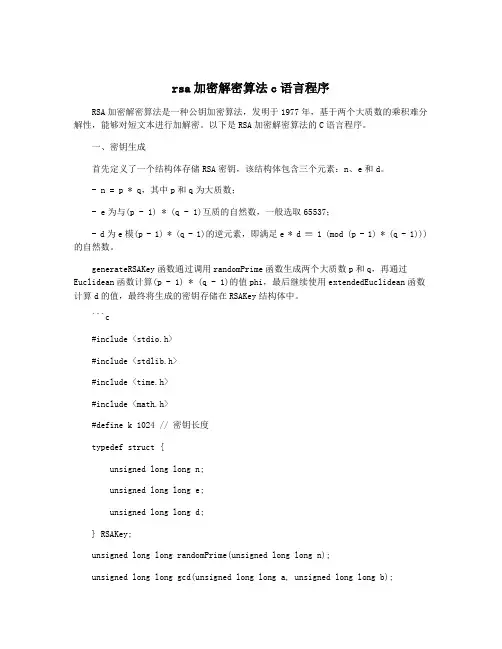
rsa加密解密算法c语言程序RSA加密解密算法是一种公钥加密算法,发明于1977年,基于两个大质数的乘积难分解性,能够对短文本进行加解密。
以下是RSA加密解密算法的C语言程序。
一、密钥生成首先定义了一个结构体存储RSA密钥,该结构体包含三个元素:n、e和d。
- n = p * q,其中p和q为大质数;- e为与(p - 1) * (q - 1)互质的自然数,一般选取65537;- d为e模(p - 1) * (q - 1)的逆元素,即满足e * d ≡ 1 (mod (p - 1) * (q - 1)))的自然数。
generateRSAKey函数通过调用randomPrime函数生成两个大质数p和q,再通过Euclidean函数计算(p - 1) * (q - 1)的值phi,最后继续使用extendedEuclidean函数计算d的值,最终将生成的密钥存储在RSAKey结构体中。
```c#include <stdio.h>#include <stdlib.h>#include <time.h>#include <math.h>#define k 1024 // 密钥长度typedef struct {unsigned long long n;unsigned long long e;unsigned long long d;} RSAKey;unsigned long long randomPrime(unsigned long long n);unsigned long long gcd(unsigned long long a, unsigned long long b);unsigned long long Euclidean(unsigned long long a, unsigned long long b);RSAKey generateRSAKey();// 生成一个小于n的随机质数unsigned long long randomPrime(unsigned long long n) {unsigned long long p;do {p = rand() % n;while (!(p & 1)) // 确保p为奇数p = rand() % n;} while (gcd(p, n) != 1); // 确保p和n互质return p;}二、加密和解密下面定义了两个函数:encrypt和decrypt,其中encrypt函数用于将明文转换为密文,decrypt函数用于将密文转换为明文。
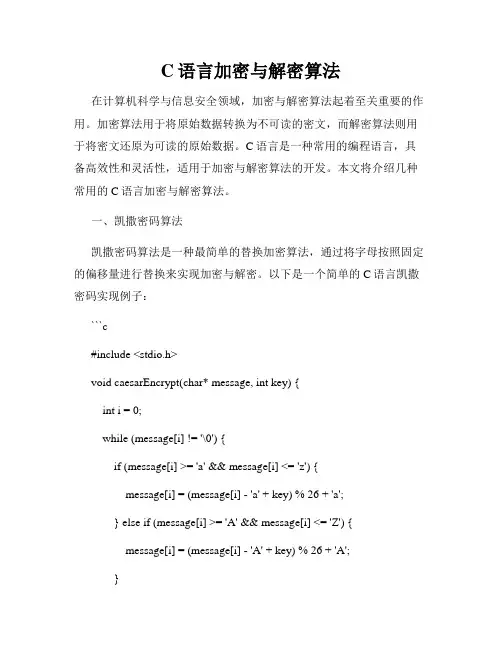
C语言加密与解密算法在计算机科学与信息安全领域,加密与解密算法起着至关重要的作用。
加密算法用于将原始数据转换为不可读的密文,而解密算法则用于将密文还原为可读的原始数据。
C语言是一种常用的编程语言,具备高效性和灵活性,适用于加密与解密算法的开发。
本文将介绍几种常用的C语言加密与解密算法。
一、凯撒密码算法凯撒密码算法是一种最简单的替换加密算法,通过将字母按照固定的偏移量进行替换来实现加密与解密。
以下是一个简单的C语言凯撒密码实现例子:```c#include <stdio.h>void caesarEncrypt(char* message, int key) {int i = 0;while (message[i] != '\0') {if (message[i] >= 'a' && message[i] <= 'z') {message[i] = (message[i] - 'a' + key) % 26 + 'a';} else if (message[i] >= 'A' && message[i] <= 'Z') {message[i] = (message[i] - 'A' + key) % 26 + 'A';}i++;}}void caesarDecrypt(char* message, int key) {int i = 0;while (message[i] != '\0') {if (message[i] >= 'a' && message[i] <= 'z') {message[i] = (message[i] - 'a' - key + 26) % 26 + 'a'; } else if (message[i] >= 'A' && message[i] <= 'Z') {message[i] = (message[i] - 'A' - key + 26) % 26 + 'A'; }i++;}}int main() {char message[] = "Hello, World!";int key = 3;printf("Original message: %s\n", message);caesarEncrypt(message, key);printf("Encrypted message: %s\n", message);caesarDecrypt(message, key);printf("Decrypted message: %s\n", message);return 0;}```以上程序演示了凯撒密码的加密与解密过程,通过指定偏移量实现对消息的加密与解密。
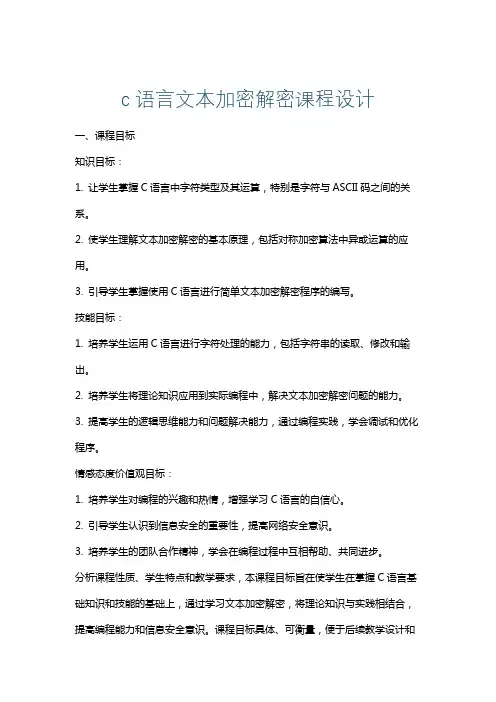
c语言文本加密解密课程设计一、课程目标知识目标:1. 让学生掌握C语言中字符类型及其运算,特别是字符与ASCII码之间的关系。
2. 使学生理解文本加密解密的基本原理,包括对称加密算法中异或运算的应用。
3. 引导学生掌握使用C语言进行简单文本加密解密程序的编写。
技能目标:1. 培养学生运用C语言进行字符处理的能力,包括字符串的读取、修改和输出。
2. 培养学生将理论知识应用到实际编程中,解决文本加密解密问题的能力。
3. 提高学生的逻辑思维能力和问题解决能力,通过编程实践,学会调试和优化程序。
情感态度价值观目标:1. 培养学生对编程的兴趣和热情,增强学习C语言的自信心。
2. 引导学生认识到信息安全的重要性,提高网络安全意识。
3. 培养学生的团队合作精神,学会在编程过程中互相帮助、共同进步。
分析课程性质、学生特点和教学要求,本课程目标旨在使学生在掌握C语言基础知识和技能的基础上,通过学习文本加密解密,将理论知识与实践相结合,提高编程能力和信息安全意识。
课程目标具体、可衡量,便于后续教学设计和评估。
二、教学内容1. C语言基础知识回顾:字符类型及其ASCII码表示,字符串处理基础。
2. 文本加密解密原理:介绍对称加密基本概念,重点讲解异或运算在文本加密解密中的应用。
3. 编程实践:- 简单文本加密程序设计:使用C语言实现字符异或加密。
- 简单文本解密程序设计:使用C语言实现字符异或解密。
4. 教学案例分析与讨论:分析教材中相关的案例,讲解加密解密程序的设计思路和实现步骤。
5. 课堂练习:设计具有实际意义的加密解密任务,让学生动手实践,巩固所学知识。
教学内容安排和进度:第一课时:C语言基础知识回顾,文本加密解密原理介绍。
第二课时:编程实践——简单文本加密程序设计。
第三课时:编程实践——简单文本解密程序设计。
第四课时:教学案例分析与讨论,课堂练习。
教学内容与教材关联性:1. C语言基础知识:参考教材第1章至第3章内容。
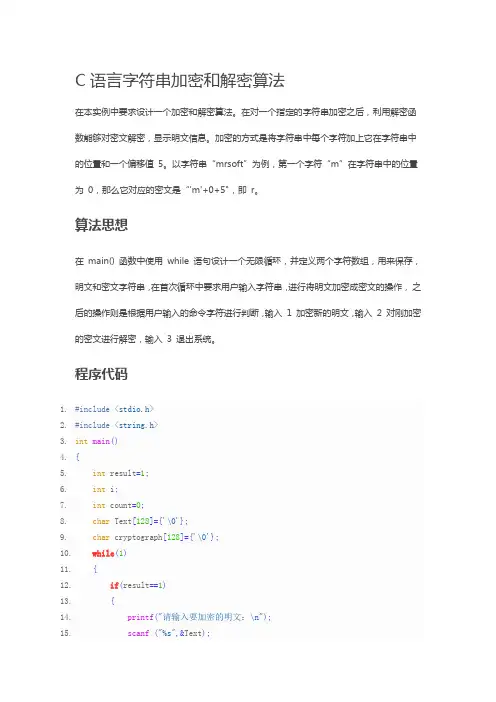
C语言字符串加密和解密算法在本实例中要求设计一个加密和解密算法。
在对一个指定的字符串加密之后,利用解密函数能够对密文解密,显示明文信息。
加密的方式是将字符串中每个字符加上它在字符串中的位置和一个偏移值5。
以字符串“mrsoft”为例,第一个字符“m”在字符串中的位置为0,那么它对应的密文是“'m'+0+5",即r。
算法思想在main() 函数中使用while 语句设计一个无限循环,并定义两个字符数组,用来保存,明文和密文字符串,在首次循环中要求用户输入字符串,进行将明文加密成密文的操作,之后的操作则是根据用户输入的命令字符进行判断,输入1 加密新的明文,输入2 对刚加密的密文进行解密,输入3 退出系统。
程序代码1.#include<stdio.h>2.#include<string.h>3.int main()4.{5.int result=1;6.int i;7.int count=0;8.char Text[128]={'\0'};9.char cryptograph[128]={'\0'};10.while(1)11.{12.if(result==1)13.{14.printf("请输入要加密的明文:\n");15.scanf("%s",&Text);16. count=strlen(Text);17.for(i=0;i<count;i++)18.{19. cryptograph[i]=Text[i]+i+5;20.}21. cryptograph[i]='\0';22.printf("加密后的密文是:%s\n",cryptograph);23.}24.else if(result==2)25.{26. count=strlen(Text);27.for(i=0;i<count;i++)28.{29. Text[i]=cryptograph[i]-i-5;30.}31. Text[i]='\0';32.printf("解密后的明文是:%s\n",Text);33.}34.else if(result==3)35.{36.break;37.}38.else39.{40.printf("请输入正确的命令符:\n");41.}42.printf("输入1加密新的明文,输入2对刚加密的密文进行解密,输入3退出系统:\n");43.printf("请输入命令符:\n");44.scanf("%d",&result);45.}46.return0;47.}调试运行结果本实例中,输入了I love Xichang College 字符串作为例证,因此输出是多个加密后的字符串,结果如下所示:。
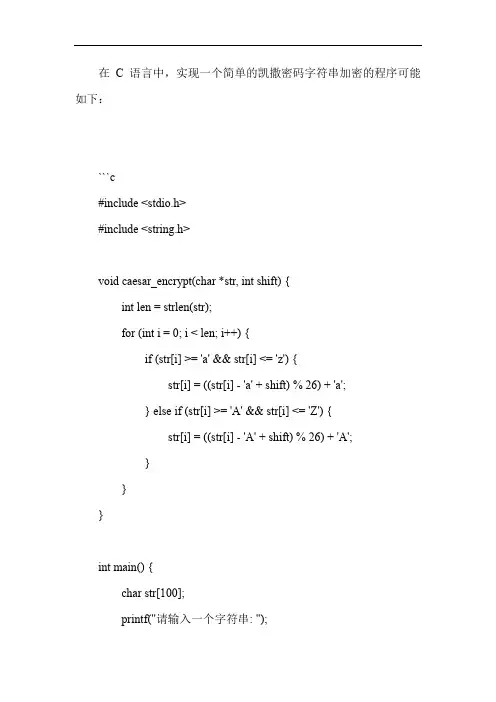
在C语言中,实现一个简单的凯撒密码字符串加密的程序可能如下:```c#include <stdio.h>#include <string.h>void caesar_encrypt(char *str, int shift) {int len = strlen(str);for (int i = 0; i < len; i++) {if (str[i] >= 'a' && str[i] <= 'z') {str[i] = ((str[i] - 'a' + shift) % 26) + 'a';} else if (str[i] >= 'A' && str[i] <= 'Z') {str[i] = ((str[i] - 'A' + shift) % 26) + 'A';}}}int main() {char str[100];printf("请输入一个字符串: ");fgets(str, sizeof(str), stdin); // 从标准输入读取字符串caesar_encrypt(str, 3); // 对字符串进行凯撒密码加密,偏移量为3printf("加密后的字符串: %s\n", str);return 0;}```这个程序首先定义了一个`caesar_encrypt`函数,该函数接收一个字符串和一个偏移量作为参数,然后对字符串中的每个字符进行凯撒密码加密。
在主函数中,我们读取用户输入的字符串,然后调用`caesar_encrypt`函数进行加密,并打印出加密后的字符串。
这个程序只处理了小写字母和大写字母,对于其他字符(如数字、标点符号等),它们将保持不变。
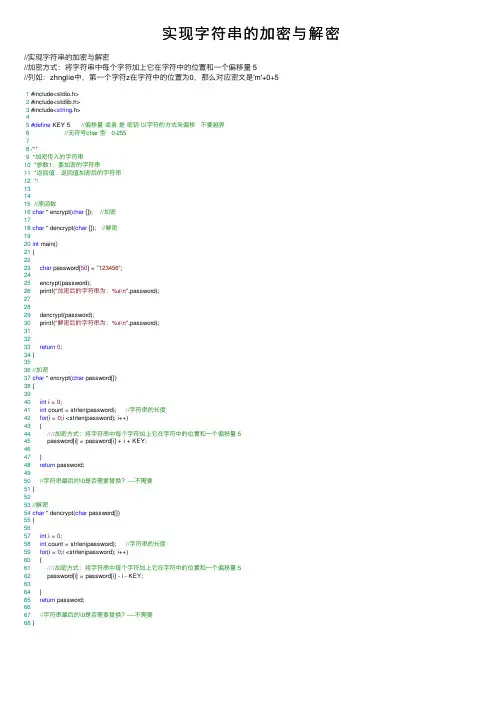
实现字符串的加密与解密//实现字符串的加密与解密//加密⽅式:将字符串中每个字符加上它在字符中的位置和⼀个偏移量 5//列如:zhnglie中,第⼀个字符z在字符中的位置为0,那么对应密⽂是'm'+0+51 #include<stdio.h>2 #include<stdlib.h>3 #include<string.h>45#define KEY 5 //偏移量或者是密钥以字符的⽅式来偏移不要越界6//⽆符号char 型 0-25578/**9 *加密传⼊的字符串10 *参数1:要加密的字符串11 *返回值:返回值加密后的字符串12*/131415//原函数16char * encrypt(char []); //加密1718char * dencrypt(char []); //解密1920int main()21 {2223char password[50] = "123456";2425 encrypt(password);26 printf("加密后的字符串为:%s\n",password);272829 dencrypt(password);30 printf("解密后的字符串为:%s\n",password);313233return0;34 }3536//加密37char * encrypt(char password[])38 {3940int i = 0;41int count = strlen(password); //字符串的长度42for(i = 0;i <strlen(password); i++)43 {44////加密⽅式:将字符串中每个字符加上它在字符中的位置和⼀个偏移量 545 password[i] = password[i] + i + KEY;4647 }48return password;4950//字符串最后的\0是否需要替换?----不需要51 }5253//解密54char * dencrypt(char password[])55 {5657int i = 0;58int count = strlen(password); //字符串的长度59for(i = 0;i <strlen(password); i++)60 {61////加密⽅式:将字符串中每个字符加上它在字符中的位置和⼀个偏移量 562 password[i] = password[i] - i - KEY;6364 }65return password;6667//字符串最后的\0是否需要替换?----不需要68 }。
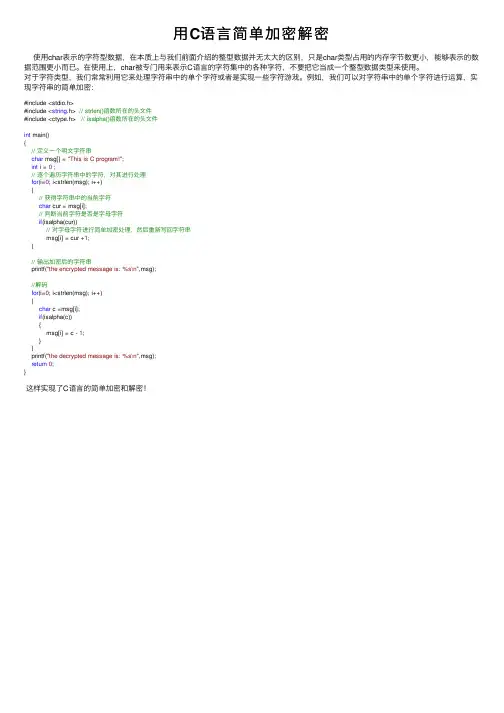
⽤C语⾔简单加密解密使⽤char表⽰的字符型数据,在本质上与我们前⾯介绍的整型数据并⽆太⼤的区别,只是char类型占⽤的内存字节数更⼩,能够表⽰的数据范围更⼩⽽已。
在使⽤上,char被专门⽤来表⽰C语⾔的字符集中的各种字符,不要把它当成⼀个整型数据类型来使⽤。
对于字符类型,我们常常利⽤它来处理字符串中的单个字符或者是实现⼀些字符游戏。
例如,我们可以对字符串中的单个字符进⾏运算,实现字符串的简单加密:#include <stdio.h>#include <string.h> // strlen()函数所在的头⽂件#include <ctype.h> // isalpha()函数所在的头⽂件int main(){// 定义⼀个明⽂字符串char msg[] = "This is C program!";int i = 0 ;// 逐个遍历字符串中的字符,对其进⾏处理for(i=0; i<strlen(msg); i++){// 获得字符串中的当前字符char cur = msg[i];// 判断当前字符是否是字母字符if(isalpha(cur))// 对字母字符进⾏简单加密处理,然后重新写回字符串msg[i] = cur +1;}// 输出加密后的字符串printf("the encrypted message is: %s\n",msg);//解码for(i=0; i<strlen(msg); i++){char c =msg[i];if(isalpha(c)){msg[i] = c - 1;}}printf("the decrypted message is: %s\n",msg);return0;}这样实现了C语⾔的简单加密和解密!。
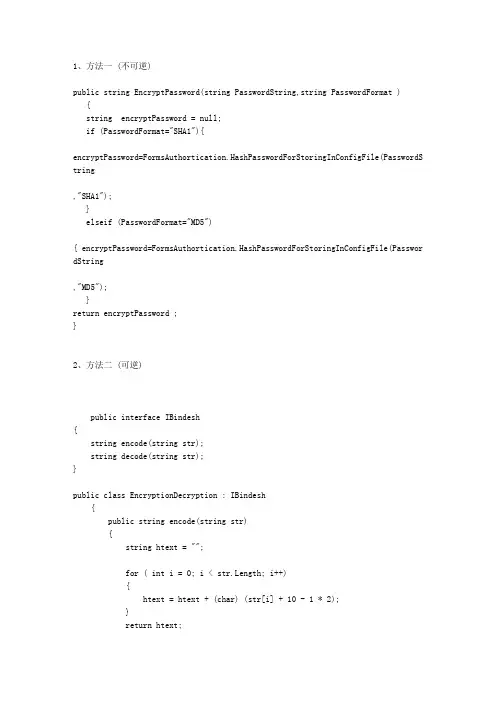
1、方法一 (不可逆)public string EncryptPassword(string PasswordString,string PasswordFormat ){string encryptPassword = null;if (PasswordFormat="SHA1"){encryptPassword=FormsAuthortication.HashPasswordForStoringInConfigFile(PasswordS tring,"SHA1");}elseif (PasswordFormat="MD5"){ encryptPassword=FormsAuthortication.HashPasswordForStoringInConfigFile(Passwor dString,"MD5");}return encryptPassword ;}2、方法二 (可逆)public interface IBindesh{string encode(string str);string decode(string str);}public class EncryptionDecryption : IBindesh{public string encode(string str){string htext = "";for ( int i = 0; i < str.Length; i++){htext = htext + (char) (str[i] + 10 - 1 * 2);}return htext;public string decode(string str){string dtext = "";for ( int i=0; i < str.Length; i++){dtext = dtext + (char) (str[i] - 10 + 1*2);}return dtext;}3、方法三 (可逆)const string KEY_64 = "VavicApp";//注意了,是8个字符,64位const string IV_64 = "VavicApp";public string Encode(string data){byte[] byKey = System.Text.ASCIIEncoding.ASCII.GetBytes(KEY_64);byte[] byIV = System.Text.ASCIIEncoding.ASCII.GetBytes(IV_64);DESCryptoServiceProvider cryptoProvider = new DESCryptoServiceProvider();int i = cryptoProvider.KeySize;MemoryStream ms = new MemoryStream();CryptoStream cst = new CryptoStream(ms, cryptoProvider.CreateEncryptor(byKey,byIV), CryptoStreamMode.Write);StreamWriter sw = new StreamWriter(cst);sw.Write(data);sw.Flush();cst.FlushFinalBlock();sw.Flush();return Convert.ToBase64String(ms.GetBuffer(), 0, (int)ms.Length);public string Decode(string data){byte[] byKey = System.Text.ASCIIEncoding.ASCII.GetBytes(KEY_64);byte[] byIV = System.Text.ASCIIEncoding.ASCII.GetBytes(IV_64);byte[] byEnc;try{byEnc = Convert.FromBase64String(data);}catch{return null;}DESCryptoServiceProvider cryptoProvider = new DESCryptoServiceProvider();MemoryStream ms = new MemoryStream(byEnc);CryptoStream cst = new CryptoStream(ms, cryptoProvider.CreateDecryptor(byKey,byIV), CryptoStreamMode.Read);StreamReader sr = new StreamReader(cst);return sr.ReadToEnd();}4、MD5不可逆加密(32位加密)public string GetMD5(string s, string _input_charset){/**//**//**//// <summary>/// 与ASP兼容的MD5加密算法/// </summary>MD5 md5 = new MD5CryptoServiceProvider();byte[] t = puteHash(Encoding.GetEncoding(_input_charset).GetBytes(s));StringBuilder sb = new StringBuilder(32);for (int i = 0; i < t.Length; i++){sb.Append(t[i].ToString("x").PadLeft(2, '0'));}return sb.ToString();}(16位加密)public static string GetMd5Str(string ConvertString){MD5CryptoServiceProvider md5 = new MD5CryptoServiceProvider();string t2 =BitConverter.ToString(puteHash(UTF8Encoding.Default.GetBytes(ConvertStrin g)), 4, 8);t2 = t2.Replace("-", "");return t2;}5、加解文本文件//加密文件private static void EncryptData(String inName, String outName, byte[] desKey, byte[]desIV){//Create the file streams to handle the input and output files.FileStream fin = new FileStream(inName, FileMode.Open, FileAccess.Read); FileStream fout = new FileStream(outName, FileMode.OpenOrCreate, FileAccess.Write);fout.SetLength(0);//Create variables to help with read and write.byte[] bin = new byte[100]; //This is intermediate storage for the encryption.long rdlen = 0; //This is the total number of bytes written. long totlen = fin.Length; //This is the total length of the input file. int len; //This is the number of bytes to be written ata time.DES des = new DESCryptoServiceProvider();CryptoStream encStream = new CryptoStream(fout, des.CreateEncryptor(desKey, desIV),CryptoStreamMode.Write);//Read from the input file, then encrypt and write to the output file.while (rdlen < totlen){len = fin.Read(bin, 0, 100);encStream.Write(bin, 0, len);rdlen = rdlen + len;}encStream.Close();fout.Close();fin.Close();}//解密文件private static void DecryptData(String inName, String outName, byte[] desKey, byte[]desIV){//Create the file streams to handle the input and output files.FileStream fin = new FileStream(inName, FileMode.Open, FileAccess.Read); FileStream fout = new FileStream(outName, FileMode.OpenOrCreate, FileAccess.Write);fout.SetLength(0);//Create variables to help with read and write.byte[] bin = new byte[100]; //This is intermediate storage for the encryption.long rdlen = 0; //This is the total number of bytes written. long totlen = fin.Length; //This is the total length of the input file. int len; //This is the number of bytes to be written at a time.DES des = new DESCryptoServiceProvider();CryptoStream encStream = new CryptoStream(fout, des.CreateDecryptor(desKey, desIV),CryptoStreamMode.Write);//Read from the input file, then encrypt and write to the output file. while (rdlen < totlen){len = fin.Read(bin, 0, 100);encStream.Write(bin, 0, len);rdlen = rdlen + len;}encStream.Close();fout.Close();fin.Close();}6、using System;using System.Collections.Generic;using System.Text;using System.Security.Cryptography;using System.IO;namespace Component{public class Security{public Security(){}//默认密钥向量private static byte[] Keys = { 0x12, 0x34, 0x56, 0x78, 0x90, 0xAB, 0xCD, 0xEF };/**//**//**//**//**//**//**//// <summary>/// DES加密字符串/// </summary>/// <param name="encryptString">待加密的字符串</param>/// <param name="encryptKey">加密密钥,要求为8位</param>/// <returns>加密成功返回加密后的字符串,失败返回源串</returns>public static string EncryptDES(string encryptString, string encryptKey){try{byte[] rgbKey = Encoding.UTF8.GetBytes(encryptKey.Substring(0, 8));byte[] rgbIV = Keys;byte[] inputByteArray = Encoding.UTF8.GetBytes(encryptString); DESCryptoServiceProvider dCSP = new DESCryptoServiceProvider(); MemoryStream mStream = new MemoryStream();CryptoStream cStream = new CryptoStream(mStream, dCSP.CreateEncryptor(rgbKey,rgbIV), CryptoStreamMode.Write);cStream.Write(inputByteArray, 0, inputByteArray.Length);cStream.FlushFinalBlock();return Convert.ToBase64String(mStream.ToArray());}catch{return encryptString;}}/**//**//**//**//**//**//**//// <summary>/// DES解密字符串/// </summary>/// <param name="decryptString">待解密的字符串</param>/// <param name="decryptKey">解密密钥,要求为8位,和加密密钥相同</param> /// <returns>解密成功返回解密后的字符串,失败返源串</returns>public static string DecryptDES(string decryptString, string decryptKey) {try{byte[] rgbKey = Encoding.UTF8.GetBytes(decryptKey);byte[] rgbIV = Keys;byte[] inputByteArray = Convert.FromBase64String(decryptString); DESCryptoServiceProvider DCSP = new DESCryptoServiceProvider(); MemoryStream mStream = new MemoryStream();CryptoStream cStream = new CryptoStream(mStream, DCSP.CreateDecryptor(rgbKey,rgbIV), CryptoStreamMode.Write);cStream.Write(inputByteArray, 0, inputByteArray.Length);cStream.FlushFinalBlock();return Encoding.UTF8.GetString(mStream.ToArray()); }catch{return decryptString;}}}}。
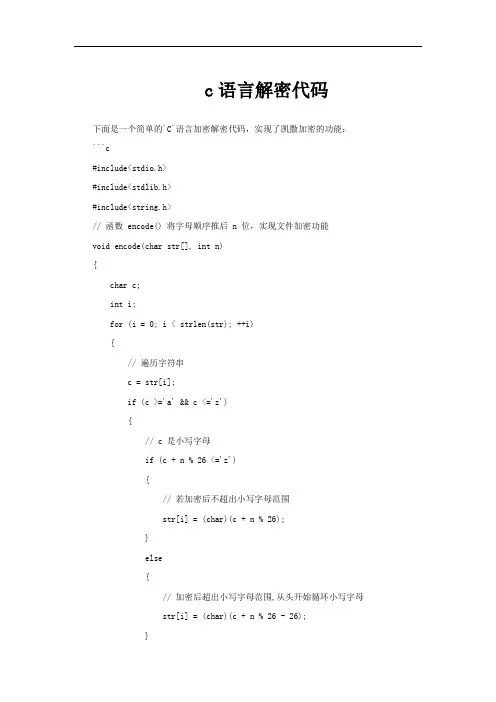
c语言解密代码下面是一个简单的`C`语言加密解密代码,实现了凯撒加密的功能:```c#include<stdio.h>#include<stdlib.h>#include<string.h>// 函数 encode() 将字母顺序推后 n 位,实现文件加密功能void encode(char str[], int n){char c;int i;for (i = 0; i < strlen(str); ++i){// 遍历字符串c = str[i];if (c >='a' && c <='z'){// c 是小写字母if (c + n % 26 <='z'){// 若加密后不超出小写字母范围str[i] = (char)(c + n % 26);}else{// 加密后超出小写字母范围,从头开始循环小写字母 str[i] = (char)(c + n % 26 - 26);}elseif (c >='A' && c <='Z'){// c 为大写字母if (c + n % 26 <= 'Z'){// 加密后不超出大写字母范围str[i] = (char)(c + n % 26);}else{// 加密后超出大写字母范围,从头开始循环大写字母 str[i] = (char)(c + n % 26 - 26);}}else{// 不是字母,不加密str[i] = c;printf("\nAfter encode: \n");puts(str);}}// 输出加密后的字符串printf("\nAfter encode: \n");puts(str);}// 实现解密功能,将字母顺序前移 n 位void decode(char str[], int n){int i;for (i = 0; i < strlen(str); ++i){c = str[i];if (c >='a' && c <='z'){// 解密后还为小写字母,直接解密if (c - n % 26 >='a'){str[i] = (char)(c - n % 26);}else{// 解密后不为小写字母了,通过循环小写字母处理为小写字母 str[i] = (char)(c - n % 26 + 26);}}elseif (c >= 'A' && c <='Z'){// c 为大写字母if (c - n % 26 >='A'){// 解密后还为大写字母str[i] = (char)(c - n % 26);}else{// 解密后不为大写字母了,循环大写字母,处理为大写字母str[i] = (char)(c - n % 26 + 26);}}else{// 不是字母,不加密str[i] = c;}}// 输出解密后的字符串printf("\nAfter decode: \n");puts(str);}int main(){char str[20];int n;printf("请输入字符串(以空格结束输入):\n");gets(str);printf("请输入密钥(1-25的整数):\n");scanf("%d", &n);printf("加密前的字符串为:%s\n", str);encode(str, n);printf("加密后的字符串为:%s\n", str);decode(str, n);printf("解密后的字符串为:%s\n", str);return 0;}```在上述代码中,加密函数`encode()`通过将字符串中的每个字符循环向后移动`n`位实现加密,解密函数`decode()`通过将字符串中的每个字符循环向前移动`n`位实现解密。

aes算法c语言实现AES(Advanced Encryption Standard)是一种广泛应用于数据加密的算法。
以下是一个使用C语言实现的AES加密算法示例,用于对字符串进行加密和解密。
这个实现是基于ECB模式的,这是一种常用的加密模式,因为它简单且易于实现。
注意:这个实现是为了教学目的而提供的,可能不适合用于生产环境。
生产环境中的加密实现通常需要更复杂和安全的方法。
```c #include <stdio.h> #include <string.h> #include <stdint.h> #include <openssl/aes.h>void AES_encrypt(const uint8_t *key, const uint8_t*plaintext, uint8_t *ciphertext) { AES_KEY aesKey; AES_set_encrypt_key(key, 128, &aesKey);AES_encrypt(plaintext, ciphertext, &aesKey); }void AES_decrypt(const uint8_t *key, const uint8_t*ciphertext, uint8_t *plaintext) { AES_KEY aesKey; AES_set_decrypt_key(key, 128, &aesKey);AES_decrypt(ciphertext, plaintext, &aesKey); }int main() { // 定义密钥和明文/密文缓冲区uint8_t key[AES_BLOCK_SIZE]; // AES_BLOCK_SIZE是AES算法的块大小,通常是16字节(128位) uint8_tplaintext[AES_BLOCK_SIZE], ciphertext[AES_BLOCK_SIZE];// 填充密钥和明文/密文缓冲区 // 这里省略了填充代码,因为在实际应用中,你应该使用合适的填充方案来保护数据的完整性。
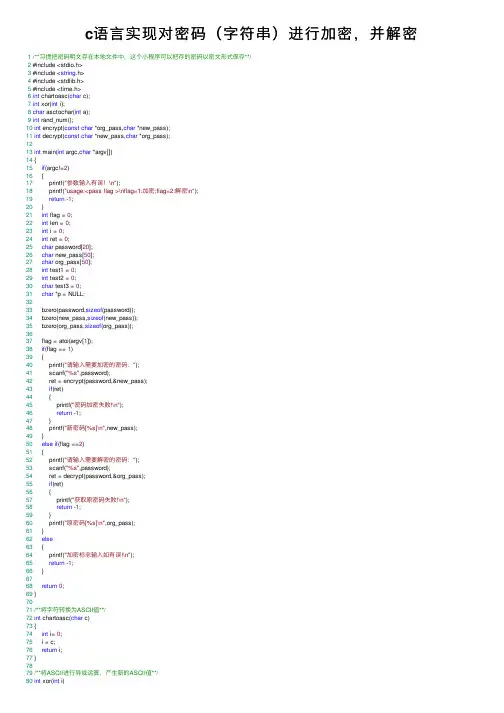
c语⾔实现对密码(字符串)进⾏加密,并解密 1/**习惯把密码明⽂存在本地⽂件中,这个⼩程序可以把存的密码以密⽂形式保存**/2 #include <stdio.h>3 #include <string.h>4 #include <stdlib.h>5 #include <time.h>6int chartoasc(char c);7int xor(int i);8char asctochar(int a);9int rand_num();10int encrypt(const char *org_pass,char *new_pass);11int decrypt(const char *new_pass,char *org_pass);1213int main(int argc,char *argv[])14 {15if(argc!=2)16 {17 printf("参数输⼊有误!\n");18 printf("usage:<pass flag >\nflag=1:加密;flag=2:解密\n");19return -1;20 }21int flag = 0;22int len = 0;23int i = 0;24int ret = 0;25char password[20];26char new_pass[50];27char org_pass[50];28int test1 = 0;29int test2 = 0;30char test3 = 0;31char *p = NULL;3233 bzero(password,sizeof(password));34 bzero(new_pass,sizeof(new_pass));35 bzero(org_pass,sizeof(org_pass));3637 flag = atoi(argv[1]);38if(flag == 1)39 {40 printf("请输⼊需要加密的密码:");41 scanf("%s",password);42 ret = encrypt(password,&new_pass);43if(ret)44 {45 printf("密码加密失败!\n");46return -1;47 }48 printf("新密码[%s]\n",new_pass);49 }50else if(flag ==2)51 {52 printf("请输⼊需要解密的密码:");53 scanf("%s",password);54 ret = decrypt(password,&org_pass);55if(ret)56 {57 printf("获取原密码失败!\n");58return -1;59 }60 printf("原密码[%s]\n",org_pass);61 }62else63 {64 printf("加密标志输⼊如有误!\n");65return -1;66 }6768return0;69 }7071/**将字符转换为ASCII值**/72int chartoasc(char c)73 {74int i= 0;75 i = c;76return i;77 }7879/**将ASCII进⾏异或运算,产⽣新的ASCII值**/80int xor(int i)81 {82int m = 27;83int result = 0;84if(59==i || 100==i)85 {86return i;87 }88 result = i^m;89return result;90 }9192/**将ASCII值转换为字符**/93char asctochar(int a)94 {95char c;96 c = a;97return c;98 }99100/**输⼊原密码产⽣新的密码**/101int encrypt(const char *org_pass,char *new_pass) 102 {103char org_password[50];104char new_password[50];105int len = 0;106int i = 0;107int asc = 0 ;108char ch = 0;109int x = 0;110111 bzero(org_password,sizeof(org_password)); 112 bzero(new_password,sizeof(new_password)); 113 strcpy(org_password, org_pass);114 len = strlen(org_password);115for(i=0 ; i<len ; i++)116 {117 ch = org_password[i];118 asc = chartoasc(ch);119 x = xor(asc);120 new_password[i] = asctochar(x);121 }122 strcpy(new_pass,new_password);123124return0;125 }126127/**输⼊加密后的密码返回原密码**/128int decrypt(const char *new_pass,char *org_pass) 129 {130char new_password[50];131char org_password[50];132char ch;133int a = -1;134int len =0;135int i=0;136int x = -1;137138 bzero(new_password,sizeof(new_password)); 139 bzero(org_password,sizeof(org_password)); 140141 strcpy(new_password,new_pass);142 len = strlen(new_password);143for(i=0;i<len;i++)144 {145 ch = new_password[i];146 a = chartoasc(ch);147 x = xor(a);148 org_password[i]=asctochar(x);149 }150 strcpy(org_pass,org_password);151152return0;153 }后续考虑实现界⾯程序的改进。
c语言实现加密解密续--获得简单小软件编写程序,实现对文本的加密及解密,要求在加密及解密时的原文件名和密文名从键盘输入,并在解密时验证用户信息即操作权限。
加密程序代码:#include<stdio.h>main(){char c,filename[20];FILE *fp1,*fp2;printf("请输入待加密的文件名:\n");scanf("%s",filename);fp1=fopen(filename,"r");fp2=fopen("miwen.txt","w");do{c=fgetc(fp1);if(c>=32&&c<=126){c=c-32;c=126-c;}if(c!=-1)fprintf(fp2,"%c",c);}while(c!=-1);}解密程序代码:#include<stdio.h>#include<string.h>main(){char c,filename[20];char yanzhengma[20];FILE *fp1,*fp2;printf("请输入待解密文件名:\n");scanf("%s",filename);printf("请输入验证码:\n");scanf("%s",yanzhengma);if(strcmp(yanzhengma,"shan")==0){fp1=fopen(filename,"r"); fp2=fopen("yuanwen.txt","w"); do{c=fgetc(fp1);if(c>=32&&c<=126){c=126-c;c=32+c;}if(c!=-1)fprintf(fp2,"%c",c);}while(c!=-1);}else{printf("验证码错误!请重新输入:\n");scanf("%s",filename);}}运行结果:文件加密:如需要加密的文件名为yusnwen.txt,则屏幕显示为:如yuanwen.txt内容为:qing dao li gong da xue tong xin yu dian zi gong cheng xue yuan 2006 ji dain zi xin xi gong cheng zhuan ye2009 05 17加密后得到的密文miwen.txt为:-507~:=/~25~7/07~:=~&)9~*/07~&50~%)~:5=0~$5~7/07~;6907~&)9~%)=0~lnnh~45~:=50~$5 ~&50~&5~7/07~;6907~$6)=0~%9~~~lnne~ni~mg文件解密:如需解密的文件即为上面加密后的文件miwen.txt,则:当验证码正确时,屏幕显示:得到的原文如加密时的原文。
C语言实现AES加密解密AES(Advanced Encryption Standard)是一种对称加密算法,它是目前广泛使用的加密标准之一、本文将介绍如何使用C语言实现AES加密和解密。
AES算法使用128位(16字节)的块进行加密和解密。
它支持128位、192位和256位长度的密钥。
在下面的示例中,我们将演示如何使用128位的密钥进行AES加密和解密。
首先,我们需要准备一个AES加密所需的密钥。
我们可以通过一个字符串来表示密钥,然后将其转换为字节数组。
在C语言中,可以使用`strncpy`函数将字符串复制到字节数组中。
```c#include <stdio.h>#include <stdlib.h>#include <string.h>#include <openssl/aes.h>#define AES_KEY_SIZE 128int mai//准备AES密钥unsigned char key[AES_KEY_SIZE/8];strncpy((char*)key, keyStr, AES_KEY_SIZE/8);//创建AES加密上下文AES_KEY aesKey;AES_set_encrypt_key(key, AES_KEY_SIZE, &aesKey); //待加密的数据unsigned char input[] = "Hello, AES!";int inputLen = sizeof(input)/sizeof(input[0]); //加密数据unsigned char encrypted[AES_BLOCK_SIZE];AES_encrypt(input, encrypted, &aesKey);//输出加密结果printf("Encrypted: ");for (int i = 0; i < AES_BLOCK_SIZE; i++)printf("%02x", encrypted[i]);}printf("\n");//创建AES解密上下文AES_set_decrypt_key(key, AES_KEY_SIZE, &aesKey); //解密数据unsigned char decrypted[AES_BLOCK_SIZE];AES_decrypt(encrypted, decrypted, &aesKey);//输出解密结果printf("Decrypted: ");for (int i = 0; i < AES_BLOCK_SIZE; i++)printf("%c", decrypted[i]);}printf("\n");return 0;```在上面的示例中,我们使用OpenSSL库提供的AES函数来执行加密和解密操作。
C语言加密与解密算法详解1. 引言在信息时代,数据的保密性至关重要。
加密与解密算法是一种重要的保护数据安全性的技术手段。
本文将详细介绍C语言中的加密与解密算法,包括常用的对称加密算法和非对称加密算法。
2. 对称加密算法2.1 Caesar密码Caesar密码是一种简单的替换密码算法,通过将每个字母向后移动固定的位数来加密消息。
解密操作是将每个字母向前移动相同的位数。
2.2 DES算法数据加密标准(DES)是一种对称加密算法,使用56位的密钥对64位的数据进行加密。
DES算法通过多轮迭代和复杂的置换与代换操作来实现高强度的加密。
3. 非对称加密算法3.1 RSA算法RSA算法是一种常用的非对称加密算法。
它通过使用两个密钥:一个公钥和一个私钥,来实现加密和解密操作。
发送方使用接收方的公钥进行加密,而接收方使用自己的私钥进行解密。
3.2 椭圆曲线加密算法椭圆曲线加密算法(ECC)是一种基于椭圆曲线数学原理的非对称加密算法。
它具有较小的密钥长度和高安全性的特点,适用于资源受限的设备。
4. 加密与解密实例4.1 使用Caesar密码加密与解密字符串下面是使用C语言实现Caesar密码算法的示例代码: ```// Caesar密码加密函数void caesarEncrypt(char* text, int key) {int i = 0;while (text[i] != '\0') {if (isalpha(text[i])) {if (islower(text[i])) {text[i] = (text[i] - 'a' + key) % 26 + 'a';} else {text[i] = (text[i] - 'A' + key) % 26 + 'A';}}i++;}}// Caesar密码解密函数void caesarDecrypt(char* text, int key) {caesarEncrypt(text, 26 - key);}```4.2 使用RSA算法加密与解密数据下面是使用C语言中的openssl库实现RSA算法的示例代码:```// RSA加密函数int rsaEncrypt(unsigned char* plainText, int plainTextLen, unsigned char* encryptedText) {// 使用公钥进行加密操作// ...}// RSA解密函数int rsaDecrypt(unsigned char* encryptedText, int encryptedTextLen, unsigned char* decryptedText) {// 使用私钥进行解密操作// ...}```5. 总结加密与解密算法在数据保密性方面发挥着重要的作用。
C语言加解密算法详解在当今信息化时代,数据的安全性和保密性变得愈发重要。
为了保护数据免遭不法分子的窃取或篡改,加密算法成为了一种常见的数据保护手段。
C语言作为一种广泛应用的编程语言,也提供了丰富的加解密算法库。
本文将详细介绍C语言中常用的加解密算法,并对其原理进行解析。
1. 凯撒密码凯撒密码是一种简单的字母替换加密算法,它通过将明文中的每个字母按照字母表中的顺序向后(或向前)移动固定的位置来进行加密。
例如,将明文字符'A'移动3个位置后,得到密文字符'D'。
解密时,只需将密文字符反向移动相同位置即可还原为明文字符。
凯撒密码的算法实现非常简单,可以使用C语言中的字符操作函数和条件语句来完成。
以下是一个使用凯撒密码加密字符串的示例代码:```c#include <stdio.h>void caesar_encrypt(char *str, int key) {int i = 0;while (str[i] != '\0') {if (str[i] >= 'A' && str[i] <= 'Z') {str[i] = ((str[i] - 'A') + key) % 26 + 'A';}else if (str[i] >= 'a' && str[i] <= 'z') {str[i] = ((str[i] - 'a') + key) % 26 + 'a';}i++;}}int main() {char str[100] = "Hello, World!";int key = 3;caesar_encrypt(str, key);printf("Encrypted string: %s\n", str);return 0;}```2. DES算法DES(Data Encryption Standard)是一种对称分组密码算法,使用56位的密钥对64位的数据进行加密和解密。
C语言实现DES加密解密算法
最近几十年里,DES(Data Encryption Standard)算法的发展起到
了极其重要的作用。
Des算法是一种基于分组密码的算法。
算法将64位
的明文数据块按位分组成8个字节,每一组以8位为单位转换成一个64
位的密文数据块,采用16轮的分组加密,每次密码变化,保证加密强度。
本文详细介绍了DES算法的C语言实现,并分别介绍了加解密算法的实现
步骤以及DES加解密测试过程。
一、DES算法C语言实现
1.函数原型
DES算法的实现包括加密和解密函数,函数原型如下:
unsigned char* DesEncrypt(unsigned char *src, unsigned char
*key); // DES加密函数
unsigned char* DesDecrypt(unsigned char *src, unsigned char
*key); // DES解密函数
输入参数src是指明文源数据,key是加解密密钥,输出参数为一个
指向加解密结果的字符串指针。
2.加解密算法
(1)DES加密算法
DES加密算法步骤如下:
(i)初始置换:将64位明文块做一次IP置换得到L0R0。
(ii)迭代轮换:对L0R0经过16次迭代轮换后,最终结果为
L16R16
(iii)逆置换:L16R16进行逆置换得到64位密文。
(2)DES解密算法
DES解密算法步骤和DES加密算法步骤是一样的,只是将置换步骤改为逆置换,将轮换步骤改为逆轮换即可。
三、DES加解密测试
1.程序测试
在C语言编写完DES加解密算法之后。
C语言中的加密与解密算法实现在计算机编程领域中,加密与解密算法的实现是非常重要的。
通过加密算法,可以将敏感数据进行保护,以防止未经授权的访问。
同时,解密算法则用于将加密过的数据恢复为原始数据。
本文将介绍C语言中加密与解密算法的实现方法,并探讨一些常用的加密算法。
一、加密算法的实现方法加密算法的实现可以采用C语言中的各种方法和技术。
下面列举了几种常用的加密算法实现方法:1. 移位加密算法移位加密算法是一种简单的加密算法,它通过将字符的ASCII码值向右移动若干位来实现。
例如,将字符'A'的ASCII码值向右移动1位,即可得到字符'B'的ASCII码值。
移位加密算法的实现如下:```cvoid encryptShift(char* message, int key) {int i = 0;while (message[i] != '\0') {message[i] = message[i] + key; // 向右移动key位i++;}}```2. 替换加密算法替换加密算法是通过将字符替换为其他字符来实现加密的。
替换加密算法可以使用预定义的映射表或通过自定义映射关系来实现。
例如,将字符'A'替换为字符'Z',将字符'B'替换为字符'Y',以此类推。
替换加密算法的实现如下:```cvoid encryptSubstitution(char* message) {int i = 0;while (message[i] != '\0') {if (message[i] >= 'A' && message[i] <= 'Z') {message[i] = 'Z' - (message[i] - 'A'); // 替换为对应的字符}i++;}}```3. 数字加密算法数字加密算法主要用于加密数字,例如将手机号码、银行账号等敏感数字进行保护。